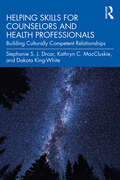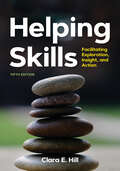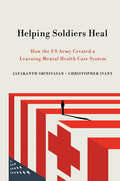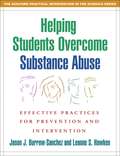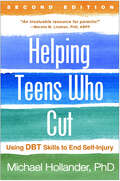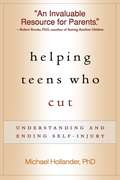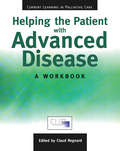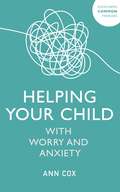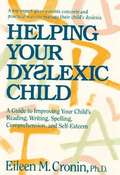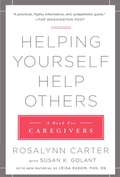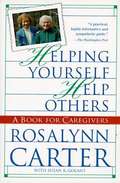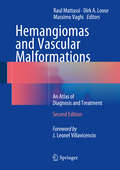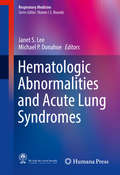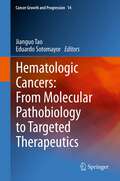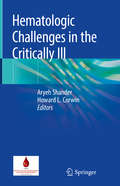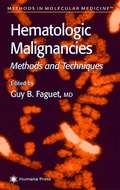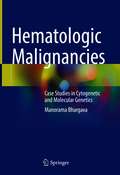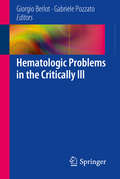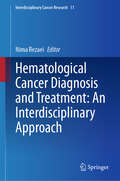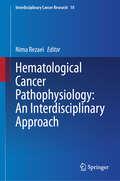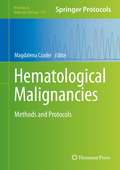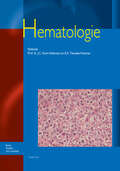- Table View
- List View
Helping Skills for Counselors and Health Professionals: Building Culturally Competent Relationships
by Kathryn C. MacCluskie Stephanie S. Drcar Dakota King-WhiteHelping Skills for Counselors and Health Professionals provides a model of foundational helping skills that is grounded in a multicultural framework. Chapters explicitly examine implicit bias and the role of culture and systems of oppression and marginalization within the lives of both individuals and communities. The text also uses ecological systems theory to assist readers in conceptualizing the ways in which culture influences communication styles, perceptions of professional helpers, and individual needs. Readers will be introduced to concepts that increase awareness of micro and macro-level influences on helping skills, communication, and the patient’s life. Within the book’s multicultural framework, readers will also find tools for increasing self-awareness for improving the communication skills and cultural humility.
Helping Skills: Facilitating Exploration, Insight, and Action
by Clara E. HillIn this fifth edition of her best‑selling textbook, Clara Hill presents an updated model of essential helping skills for undergraduate and first‑year graduate students. Hill&’s model consists of three stages—exploration, insight, and action—in which helpers guide clients in exploring their thoughts and feelings, discovering the origins and consequences of maladaptive thoughts and behaviors, and acting on those discoveries to create positive long‑term change. This book synthesizes the author&’s extensive clinical and classroom experience into an easy‑to‑read guide to the helping process. Aspiring helping professionals will learn the theoretical principles behind the three‑stage model and fundamental clinical skills for working with diverse clients. Hill also challenges students to think critically about the helping process, their own biases, and what approach best aligns with their therapeutic skills and goals. New to this edition are: detailed guidelines for developing and revising case conceptualizations, expanded coverage of cultural awareness, updated case examples that reflect greater diversity among clients and helpers, and additional strategies for addressing therapeutic challenges.
Helping Soldiers Heal: How the US Army Created a Learning Mental Health Care System (The Culture and Politics of Health Care Work)
by Jayakanth Srinivasan Christopher IvanyHelping Soldiers Heal tells the story of the US Army's transformation from a disparate collection of poorly standardized, largely disconnected clinics into one of the nation's leading mental health care systems. It is a step-by-step guidebook for military and civilian health care systems alike. Jayakanth Srinivasan and Christopher Ivany provide a unique insider-outsider perspective as key participants in the process, sharing how they confronted the challenges firsthand and helped craft and guide the unfolding change.The Army's system was being overwhelmed with mental health problems among soldiers and their family members, impeding combat readiness. The key to the transformation was to apply the tenets of "learning" health care systems. Building a learning health care system is hard; building a learning mental health care system is even harder. As Helping Soldiers Heal recounts, the Army overcame the barriers to success, and its experience is full of lessons for any health care system seeking to transform.
Helping Students Overcome Substance Abuse: Effective Practices for Prevention and Intervention
by Leanne S. Hawken Jason J. Burrow-SanchezTwo professors at the University of Utah explore adolescent substance abuse prevalence, assessment, prevention, group interventions, individual interventions, and the referral process. Intended for school mental health professionals, the guide outlines the major substances of abuse, the steps in the screening process, research-based prevention programs, the developmental stages of therapy groups, and an action plan for community-based services. Annotation ©2007 Book News, Inc., Portland, OR (booknews.com)
Helping Teens Who Cut, Second Edition: Using DBT Skills to End Self-Injury
by Michael HollanderDiscovering that your teen &“cuts&” is every parent's nightmare. Your most urgent question is: "How can I make it stop?" Tens of thousands of worried parents have turned to this authoritative guide for information and practical guidance about the growing problem of teen self-injury. Dr. Michael Hollander is a leading expert on dialectical behavior therapy (DBT), the most effective treatment approach for cutting. Vivid stories illustrate how out-of-control emotions lead some teens to hurt themselves, how DBT can help, and what other approaches can be beneficial. You'll learn practical strategies for talking to teens about self-injury without making it worse, teaching them skills to cope with extreme emotions in a healthier way, finding the right therapist, and helping reduce stress for your whole family. Incorporating the latest research, the second edition offers a deeper understanding of the causes of self-injury and includes new DBT skills.
Helping Teens Who Cut: Understanding and Ending Self-injury
by William Pollack Michael HollanderDiscovering that your teen "cuts" is absolutely terrifying; before you understand what really motivates cutting, you may worry your child is contemplating suicide. What can you do to help when every attempt to address the behavior seems to push him or her further away? In this compassionate, straightforward book, Dr. Michael Hollander, a leading authority on self-injury, spells out the facts about cutting--and what to do to make it stop. You'll learn how overwhelming emotions lead some teens to hurt themselves, and how proven treatments--chief among them dialectical behavior therapy (DBT)--can help your child become well again. Helping Teens Who Cut demonstrates how to talk to your teen about cutting without making it worse, and explains exactly what to look for in a therapist or treatment program. Drawing on decades of clinical experience as well as the latest research, Dr. Hollander provides concrete ways to help your son or daughter cope with extreme emotions without resorting to self-injury. You'll also learn practical communication and problem-solving skills that can reduce family stress, making it easier to care for yourself and your teen during the recovery process.
Helping The Patient with Advanced Disease: A Workbook
by Claude RegnardHelping others to learn about caring for people with advanced disease has always been a fundamental part of effective palliative care. This flexible learning material, formally evaluated by the Open University, is based on the Current Learning in Palliative Care (CLIP) worksheets to cover all aspects of palliative care. Easy to use, with activities throughout, they can be reproduced as handouts when presenting to a group, or used individually alongside a tutor, or within a group setting. Each worksheet is carefully structured and assigned a learning level from introductory to advanced, to give the reader an indication of how much experience or knowledge is needed to carry out the exercise. This book provides an essential resource to arm health professionals, carers and teams with the knowledge and skills needed in their daily work.
Helping Your Child with Worry and Anxiety
by Ann CoxAre you worried about your child's mental health?Is your child or teenager showing worrying signs or symptoms?Are you waiting for a CAMHS referral, or professional treatment for your child?Helping Your Child with Worry and Anxiety is written by a team of mental health care professionals who have decades of experience working with children and young people. If your child is showing signs of anxiety or any related mental health condition, if you're thinking about consulting a professional or even on the waiting list to see one, this book will have plenty of practical strategies to support both them and you. It covers everything from spotting symptoms to managing things at home - and how/when to seek further help if you think it might be necessary. It offers advice and insight into almost every possible anxiety-related condition your child might experience, including:* Worry* Fears and phobias* Worries about eating and eating disorders* Anxiety and self-harm* Separation and social anxiety* Obsessive/compulsive behavioursThere are plenty of suggestions for how to help manage your own physical and mental health during challenging times, too. Most importantly, you can feel confident and safe as you support your child, as the advice in this book comes directly from experts with a speciality in each area, who have first-hand experience of working with children and young people in the healthcare system.
Helping Your Child with Worry and Anxiety
by Ann CoxAre you worried about your child's mental health?Is your child or teenager showing worrying signs or symptoms?Are you waiting for a CAMHS referral, or professional treatment for your child?Helping Your Child with Worry and Anxiety is written by a team of mental health care professionals who have decades of experience working with children and young people. If your child is showing signs of anxiety or any related mental health condition, if you're thinking about consulting a professional or even on the waiting list to see one, this book will have plenty of practical strategies to support both them and you. It covers everything from spotting symptoms to managing things at home - and how/when to seek further help if you think it might be necessary. It offers advice and insight into almost every possible anxiety-related condition your child might experience, including:* Worry* Fears and phobias* Worries about eating and eating disorders* Anxiety and self-harm* Separation and social anxiety* Obsessive/compulsive behavioursThere are plenty of suggestions for how to help manage your own physical and mental health during challenging times, too. Most importantly, you can feel confident and safe as you support your child, as the advice in this book comes directly from experts with a speciality in each area, who have first-hand experience of working with children and young people in the healthcare system.
Helping Your Dyslexic Child: A Guide to Improving Your Child's Reading, Writing, Spelling, Comprehension, and Self-Esteem
by Eileen CroninCronin gives parents very clear descriptions of the behaviors which generally accompany the different presentations of dyslexia. Then, she outlines straightforward steps for capitalizing on the child's abilities A sensible and informative approach to coping with this set of learning challenges..
Helping Yourself Help Others
by Susan K. Golant Rosalynn CarterThe chances are good that every one of us will become a caregiver at some point in our lives. We come to this challenge in the most personal way possible?we want to help someone we love, but we donOCOt know how, and weOCOre afraid of losing ourselves in this daunting task. If you have picked up this book, you are probably a caring person. You may prove that every day by helping someone who is elderly or developmentally disabled or who suffers from a physical or mental illness. It helps to know that Rosalynn Carter, former First Lady and a director of the Rosalynn Carter Institute for Human Development, which is committed to studying caregiving issues, knows firsthand the challenges of this labor of love. From her own personal experience as a caregiver for her father and grandfather and from that of hundreds of caregivers she has encountered before, during, and since her years in the White House, Mrs. Carter knows that caregiving can be rewarding, but also lonely, stressful, confusing, and frustrating. In "Helping Yourself Help Others," Mrs. Carter writes, ?Caregivers give so much of themselves and sometimes receive very little in return. The purpose of this book is to encourage you, to empathize with you, and to advocate for your special needs. I hope it will help you have an easier and more enjoyable life. OCO Mrs. Carter addresses the issues most caregivers face. How do you avoid burnout?the sense of feeling completely overwhelmed and unrewarded? How do you balance your responsibilities as a caregiver with the rest of your life? How can you enlist the aid of other family members? How can you educate yourself about your loved oneOCOs condition and work more effectively with the health care team? When is an institution the right choice for your loved one? How can you access helpful associations, literature and government aid? (A helpful appendix lists hundreds of resources. ) "Helping Yourself Help Others" is a rare combination of a warmly personal account of caregiving and a reassuring, clear-eyed guidebook that offers practical solutions to caregiverOCOs typical problems. Filled with empathy, this sensitive, encouraging guide will help you meet a difficult challenge head-on and find fulfillment and empowerment in your caregiving role. "
Helping Yourself Help Others: A Book for Caregivers
by Susan K. Golant Rosalynn CarterHaving cared at home for her ailing father and grandfather, Rosalynn Carter's involvement has taught her that Americans are in the middle of a caregiving crisis. In this book, Mrs. Carter addresses the social issues that have created this crisis and offers practical solutions to the problems caregivers typically experience, such as isolation, burnout, anger, and helplessness.
Helping: Resources To Improve Emotional Health And Strengthen Relationships (Childrens Safety Ser.)
by Linda Johns Lisa Fox Janine ScottNIMAC-sourced textbook
Hemangiomas and Vascular Malformations
by Raul Mattassi Dirk A. Loose Massimo VaghiSince the first edition of this book was published, much new knowledge has been gained on hemangiomas and vascular malformations. This revised and updated second edition, written by worldwide leaders in the field, fully reflects this progress. Important improvements in the treatment of hemangiomas are reviewed, including the use of beta-blockers and other medical therapies as well as advances in interventional treatments and the treatment of hemangiomas in specific locations. Vascular malformations are being investigated with increasing frequency all over the world and new challenges are emerging regarding both diagnosis and treatment. This edition considers the current role of the full range of diagnostic imaging techniques -magnetic resonance imaging, computed tomography, nuclear medicine techniques, angiography, and phlebography. The various treatment options, including laser, interventional radiological, and surgical techniques, are then presented in detail. A further individual section is devoted to the study and treatment of lymphatic malformations and dysplasias, and a series of chapters also focus on problems in the treatment of malformations in particular locations, including the thorax and viscera. This book, in atlas format, is exceptional in providing clinically relevant information on the diagnosis and treatment of both hemangiomas and vascular malformations. It will appeal to all professionals who encounter these conditions in their daily clinical practice.
Hematologic Abnormalities and Acute Lung Syndromes
by Janet S. Lee Michael P. DonahoeThis book provides a unique frame work for examining acute lung syndromes that arise from hematologic disorders or is defined by a hematologic abnormality as a key feature. Acute lung processes arising from hematologic disorders can present as life-threatening conditions, and as such, the pulmonary physician or critical care physician are often directly involved in care or called upon to provide expertise. Chapters are organized into three sections, each with an emphasis on pathogenesis and current understanding of mechanisms. The text begins with the central theme of the lungs as the direct interface between the external environment and blood, description of individual components of the hematopoietic system, their function and relevance to the lungs. The second section outlines both benign and malignant primary hematologic disorders that can lead to acute pulmonary manifestations. The final section focuses on acute lung syndromes stemming from complications of transfusion and treatment. Chapters are presented in an easy-to-access format, providing information on diagnosis, management, and outcomes. This is a valuable resource for pulmonary fellows in training, pulmonologists, critical care physicians, and physicians involved in caring for patients in the ICU.
Hematologic Cancers: From Molecular Pathobiology to Targeted Therapeutics
by Eduardo Sotomayor Jianguo TaoIn the last decade, there has been a remarkable explosion of knowledge in hematologic cancer from basic molecular biology and pathology to clinical therapy. This has led to many new advance and insights in the understanding of pathobiology of malignant hematology. New knowledge of disease molecular pathology, cytogenetic, epigenetic and genomic alterations have provided new strategies to attack and eradicate tumor cells at molecular level and significantly impacted our current therapeutics for hematological malignancies. The recent and ongoing rapid expansion of knowledge in this area has become extensive, dynamic and diffuse over the literature and research publications. This has led to the need to capture and compile the new and current information about hematologic cancer with special emphasis on translation from molecular pathobiology to targeted therapeutics. In this book experts from around the world share their thoughts and knowledge about the pathobiology of hematologic cancer, as well as their view on current treatment approaches and future development in these malignant hematologic diseases. This book is well suited for hematology residents, fellows and hematology-oncology physicians, hematopathologist as well as basic research scientist in the area of hematologic malignancies.
Hematologic Challenges in the Critically Ill
by Aryeh Shander Howard L. CorwinThis volume provides a comprehensive overview of hematologic issues that clinicians regularly encounter in the critical care environment. The text features hematologic scenarios that affect the adult ICU patient, outlines pathogenesis and challenges associated with the hematologic disorder, and offers treatment modalities. Hematologic issues covered include anemia, hemostatic abnormalities, and risks of transfusion. The book also details challenges in specific ICU populations, such as patients afflicted with liver disease, brain injury, sepsis, cardiovascular disease, malignancy, and trauma. Written by experts in the field, Hematologic Challenges in the Critically Ill is a valuable resource for clinicians in the critical care environment who treat critically ill patients afflicted with hematologic complications.
Hematologic Malignancies
by Guy B. FaguetIn Hematologic Malignancies: Methods and Techniques, a panel of acknowledged experts review many of the key molecular methods used for the diagnosis and subsequent management of hematologic malignancies. These clinically relevant techniques range from routine test procedures to highly sophisticated methods currently offered only by specialized reference laboratories, and fall into five major groups: cytogenetics, polymerase chain reaction, flow cytometry, cytochemistry and immunochemistry, and apoptosis and cytokine receptors. Serving both clinical and experimental needs, Hematologic Malignancies: Methods and Techniques provides an array of powerful tools that will guide clinicians- especially hematologists, oncologists, and pathologists-to better diagnose and manage their patients with hematologic malignancies, and enable researchers to assess the anticancer effect of agents that impact cancer cells at the molecular level.
Hematologic Malignancies: Case Studies in Cytogenetic and Molecular Genetics
by Manorama BhargavaThis book is a compendium of case studies in hematologic malignancies such as acute leukemias, myelodysplastic and myeloproliferative neoplasms, chronic leukemias and multiple myeloma covering cytogenetics (karyotyping Fluorescence in sitn hybridization (FISH)) and molecular studies in detail. The first few chapters describe the methodology employed for karyotyping, FISH and Real Time PCR technology conducive to establishment of these labs if required. Each case study is described in detail by including the clinical history of the patient, findings of peripheral blood, bone marrow aspirate and bone biopsy morphological details. This is then followed by flowcytometric immunophenotyping, cytogenetic and molecular observations leading collectively to a final diagnosis, A discussion follows based on the relevance of this data in informing the prognosis, treatment response and survival in these patients. Additionally, this data serves as a key determinant for clinical decision making involving evidence based rational management of patients including targeted therapy. For better understanding, each case study is accompanied by black and white or colour images as appropriate. This book is a source of learning and a valuable read for clinical hematologists, hematopathologists, medical oncologists, residents, interns, DM Hematology students and DNB Hematology students as well.
Hematologic Problems in the Critically Ill
by Giorgio Berlot Gabriele PozzatoThis book covers a wide array of hematologic problems commonly encountered in the daily practice of critical care and emergency medicine. Unfortunately, the symptoms and signs associated with underlying hematologic disorders are frequently rather unspecific and confounding; furthermore, the clinical course of patients admitted to intensive care units with such disorders can be fulminant, warranting prompt diagnosis. This book recognizes the importance of accurate and speedy interpretation of symptoms in that the text is symptom oriented rather than disease oriented. Put another way, the reader confronted with a particular clinical problem or symptom will be guided step by step to the possible underlying disorder(s). The scenarios considered include critical illness in patients with anemia, leukopenia, leukocytosis, abnormal platelet count, and severe transfusion reactions. For each circumstance, factors relevant to symptom interpretation are fully discussed. In addition, helpful diagnostic algorithms are presented in the form of flow charts that will assist in decision making regarding the need for further investigations. The closing chapter is devoted to the drug-induced hematologic disorders. Although the book is intended mainly for intensivists, other specialists will find much information of value for their daily practice.
Hematological Cancer Diagnosis and Treatment: An Interdisciplinary Approach (Interdisciplinary Cancer Research #11)
by Nima RezaeiThe “Hematological Cancer Diagnosis and Treatment: An Interdisciplinary Approach” is the eleventh volume of the “Interdisciplinary Cancer Research” series, publishes a comprehensive volume on the diagnosis and treatment of hematological cancers. The eleventh volume of the book, entitled “Hematological Cancer Diagnosis and Treatment: An Interdisciplinary Approach” starts with a general title on stem cell therapy and hematological cancers. Diagnosis and therapy for acute myeloid leukemia, chronic lymphocytic leukemia, multiple myeloma, and lymphoma are explained in this volume. This is the main concept of Cancer Immunology Project (CIP), which is a part of Universal Scientific Education and Research Network (USERN). This interdisciplinary book will be of special value to hematologists and oncologists who wish to extend their knowledge on hematological cancer.
Hematological Cancer Pathophysiology: An Interdisciplinary Approach (Interdisciplinary Cancer Research #10)
by Nima RezaeiHematological cancers or blood cancers are a heterogeneous group of malignant neoplasms, including leukemia, lymphoma, and myeloma, primarily affect the blood and bone marrow. The “Hematological Cancer Pathophysiology: An Interdisciplinary Approach” is the tenth volume of the “Interdisciplinary Cancer Research” series, publishes a comprehensive volume on the pathophysiology of hematological cancers. This volume has an interdisciplinary approach in hematological cancers, including myeloproliferative neoplasms, T-cell lymphoma, Hodgkin's lymphoma, non-Hodgkin's lymphoma, and intraocular lymphoma. Waldenstrom macroglobulinemia and IgG4-related diseases are also discussed in the last chapters. This interdisciplinary series is of special value to researchers working on hematology and oncology. This is the main concept of Cancer Immunology Project (CIP), which is a part of Universal Scientific Education and Research Network (USERN). This interdisciplinary book will be of special value to hematologists and oncologists who wish to extend their knowledge on hematological cancers.
Hematological Complications in Obstetrics, Pregnancy, and Gynecology
by Rodger L. Bick Eugene Frenkel William Baker Ravindra SarodeThere are many hematological complications associated with obstetrics, pregnancy and gynecology, and unfortunately, they often lead to significant morbidity or mortality for both mother and child. As the first comprehensive reference on all aspects of hematological complications of obstetrics, pregnancy and gynecology this book will be a valuable resource to hematologists, obstetricians, gynecologists, reproductive medicine specialists, internists, anesthesiologists and others. The chapters are written by acknowledged experts in the field, and for each condition covered the etiology, pathophysiology, clinical and laboratory diagnosis and management are discussed where appropriate.
Hematological Malignancies
by Magdalena CzaderIncreased knowledge on the pathogenesis of hematologic diseases has been translated into diagnostic and prognostic applications. Hematopathology and laboratory hematology were among the first disciplines to embrace molecular diagnostics. Hematological Malignancies:Methods and Protocols, explores molecular-based assays frequently used in the routine diagnostic hematopathology and laboratory hematology. Many of these protocols were initially developed as research applications and were further refined as they transitioned to the diagnostic laboratory. Written in the highly successful Methods in Molecular BiologyTM series format, chapters include introductions to their respective topics, lists of the necessary materials and reagents, step-by-step, readily reproducible laboratory protocols, and key tips on troubleshooting and avoiding known pitfalls. Authoritative and practical, Hematological Malignancies: Methods and Protocols aids scientist in the continuing study of tests essential for contemporary laboratory diagnostics of hematological neoplasms.
Hematologie
by E.A. Tanasale-Huisman J.C. Kluin-NelemansHet boek Zorg rondom hematologie maakt deel uit an de Zorg rondom-reeks. Dit is een boekenreeks met boeken die vooral worden voorgeschreven in de opleiding tot verpleegkundig specialist. De reeks bestaat uit 8 delen, waarvan het deel Oncologie (wordt op dit moment ook herzien) en hematologie in de opleiding tot oncologieverpleegkundige worden voorgeschreven.
